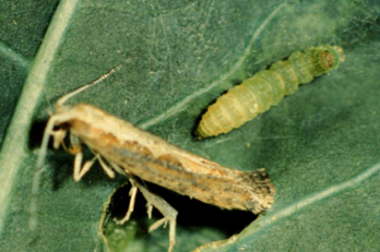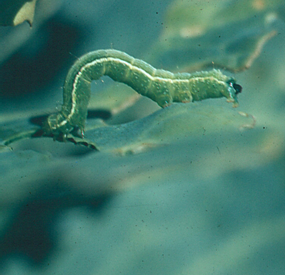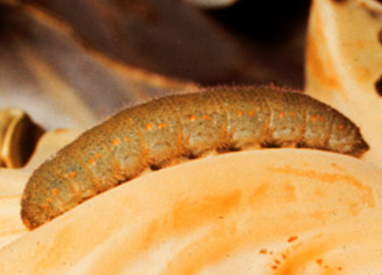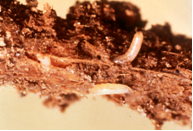
Karen Delahaut, UW-Madison Fresh Market Vegetable Program
Revised: 5/28/2004
Item number: XHT1031
The diamondback moth (Plutella xylostella) is a lepidopteran insect and an important pest of cole crops in Wisconsin. All cole crops, including cabbage, broccoli, Brussels sprouts, cauliflower, and rutabaga, are susceptible to attack by this insect.
Appearance: The diamondback moth is a small, greyish-brown, night-flying moth with a one inch wingspan. When at rest, the moth holds its wings together, roof-like, over its back. When in this position, a pattern of three diamond-shaped spots can be seen along the top of the moth’s body. The small caterpillars (up to 3∕8 inch long at maturity) are pointed at both ends and range in color from cabbage green to yellow. When disturbed, larvae rapidly wiggle their bodies back and forth, often causing them to fall off plants.
Symptoms and Effects: Diamondback moth larvae feed on cole crop leaves between the large veins and midribs. They prefer to feed on the lower leaf surface, leaving the upper epidermis intact thereby creating a “window-paning” effect. Severe feeding damage will stunt cabbage and cauliflower heads. Larval damage to the developing buds on young cabbages can cause heads to abort. Diamondback moth damage to root crops is generally of little economic importance.
Life Cycle: The diamondback moth overwinters as an adult, and therefore is an early season pest. However, cold winters increase mortality except in protected sites. In the early spring, females lay eggs on weeds in the mustard family. The first instar larvae mine between the leaf surfaces. After completing four larval stages they spin a white silk cocoon on the lower portion of the plant. There are typically three to five generations of the diamondback moth per year in Wisconsin.
Scouting Suggestions: Scout fields weekly throughout the season for damage. Check plants carefully, even if no feeding damage is apparent, to look for eggs that will hatch into small caterpillars several days to a week later. Examine the lower leaves of plants for the larvae of each pest. Although feeding damage and fecal material are signs of activity, it’s better to rely on larvae counts to determine the level of infestation. Caterpillars cause varying amounts of damage depending on the maturity of the plant, so the need for treatment changes as the crop grows. Keep a record of the life stage and the percentage of plants infested. This information will be useful for monitoring whether the population is increasing or decreasing.
Treatment thresholds are well established and are based on the percent infestation by any lepidopteran species and varies based on the stage of crop development. Cabbage, broccoli, and cauliflower in the seed bed are particularly susceptible to damage and therefore when 10% of the plants are infested with cabbage loopers, diamondback moths or imported cabbageworms, control is warranted. For cabbage between transplant and cupping, the economic threshold (ET) is raised to 30%. Once the plants have begun to cup, until early heading, if greater than 20% of plants are infested, treatment is warranted. From early heading until harvest, the threshold drops back to 10% to protect the market quality of the produce. For broccoli and cauliflower between transplant and first flower or curd, the threshold is increased to 50%. However once flowers or curds begin to develop, the economic threshold drops back to 10% to maintain a high level of quality.
Control
Cultural: Effective integrated pest management (IPM) programs for imported cabbageworm should be designed to prevent damage, encourage natural control, and avoid resistance. The use of transplants that are free of larval contamination is a key step in avoiding damage. Floating row covers can provide a physical barrier to imported diamondback moths in small cole crop plantings. Natural controls are frequently quite effective in preventing buildups of diamondback moth populations.
Chemical: Bacillus thuringiensis var Kurstaki or Aisawai applied to early instar larvae can be very effective in controlling diamondback moths. Chemical insecticides can also be effective in controlling caterpillar pests of cole crops. Refer to University of Wisconsin-Extension publication Commercial Vegetable Production in Wisconsin for specific insecticide recommendations. Target early instar larvae and insure good plant coverage to improve efficacy when using insecticides. Use pest-specific insecticides in early to mid-season when diamondback moths are prevalent so that natural enemies are conserved.
Resistance is a key concern with all lepidopteran pests on cole crops. Extensive resistance to organophosphate, pyrethroid, and carbamate insecticides has been documented in the diamondback moth. Resistant larvae are easily transported into Wisconsin on transplants. Diamondback moth resistance to Bacillus thuringiensis has also been documented in parts of the United States, but hasn’t been found in Wisconsin to date.
Download Article





 Cabbage Looper
Cabbage Looper Imported Cabbageworm
Imported Cabbageworm Cabbage Maggot
Cabbage Maggot Degree Days for Common Fruit & Vegetable Insect Pests
Degree Days for Common Fruit & Vegetable Insect Pests


